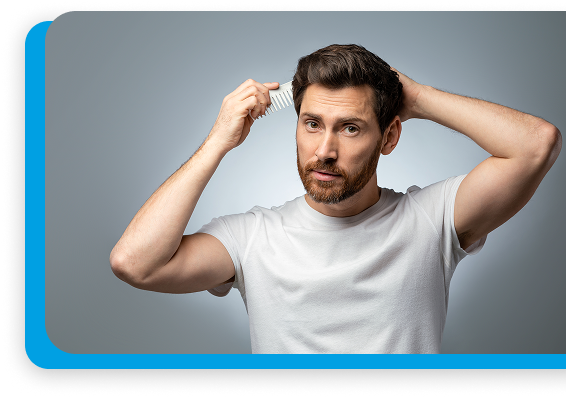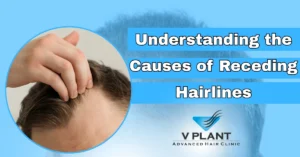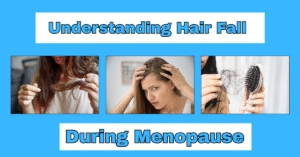Understanding the causes of receding hairlines is the first step toward taking back control over your hair health and finding a real solution to hair loss. A receding hairline—where the hair gradually thins and moves back from the forehead—is commonly caused by genetics, stress, hormonal changes, and even everyday hair practices like tight hairstyles. Hair loss impacts both men and women and is frequently associated with androgenetic alopecia, a hereditary condition recognized as the most widespread type of hair loss across all age groups.
If you’re starting to lose hair around your hairline, you’re far from alone. The good news is that there are now many effective treatments for hair loss, including various types of hair transplant procedures, medications, and holistic care routines that encourage hair regrowth and long-term maintenance.
Why Receding Hairlines Happen: Key Causes Behind Hair Loss
Hair loss rarely stems from a single source. It’s usually a mix of lifestyle, genetics, medical conditions, and environmental exposure. Recognizing what’s behind your hairline recession helps you choose the best solution for hair loss, set realistic hair transplant expectations, and protect your existing hair from further damage.
- Genetics & Androgenetic Alopecia
Known widely as male or female pattern baldness, androgenetic alopecia is the primary reason behind receding hairlines. It typically begins at the temples or crown, steadily advancing over time. The root cause lies in heightened sensitivity to DHT, a hormone that leads to the shrinking of hair follicles and restricts new hair growth.
Catching this early gives you more options, from medications like minoxidil and finasteride to professional hair transplant surgeries using methods like FUE hair transplantations, FUT, DHI, or the modern MHI technique.
- Lifestyle, Stress & Diet
Even with a genetic predisposition, your lifestyle can speed up how quickly you lose hair. Poor diet, lack of rest, and chronic stress raise cortisol levels, which can disrupt the hair cycle—leading to visible thinning around the hairline and bald spots.
To encourage hair regrowth, your body needs essential nutrients like iron, biotin, zinc, and omega-3 fatty acids. Working with a certified nutritionist can help you craft a diet that strengthens scalp health and naturally promotes new hair growth.
- Hormonal Imbalances & Health Issues
Health conditions such as thyroid imbalances, polycystic ovary syndrome (PCOS), and various autoimmune disorders can disrupt the natural hair growth cycle, leading to increased shedding and thinning.These imbalances may even Damage to the donor area can significantly reduce the chances of success in hair transplant techniques, as this region provides the healthy hair follicles needed for effective grafting and natural-looking results.If the donor site lacks healthy hair grafts, your options for follicular unit transplantation (FUT) or follicular unit extraction (FUE) may be limited.
Early medical intervention is key. Treating underlying health issues not only slows down hair loss but also improves the outcome of future hair transplant procedures.
- Environmental Damage & Hair Care Habits
Your hair is also impacted by your environment and daily routines. Frequent heat styling, harsh chemicals, and tight hairstyles damage the hair follicle, particularly around the recipient area. Over time, even the donor site can become compromised—limiting your future options for hair restoration.
Switch to gentle, sulfate-free shampoos. Reduce the use of hot tools and nourish your scalp with natural oils like argan or coconut. These small steps help protect both the recipient area and donor area, especially if you’re planning a hair transplant surgery in the future.
Exploring Hair Restoration: The Modern Solution to Hair Loss
If lifestyle changes and medication aren’t enough, it’s time to explore more lasting solutions. Consulting a hair transplant surgeon can open the door to customized, long-term hair restoration options that match your unique type of hair loss.
Types of Hair Transplant Techniques
Modern hair transplant procedures are precise, minimally invasive, and deliver natural-looking results. Here are the most effective types of hair transplant methods available today:
- Follicular Unit Extraction (FUE) is a refined hair transplant technique where individual hair grafts are harvested from the donor area and implanted into areas experiencing thinning. FUE hair transplantations are popular for producing minimal scars and allowing quicker recovery times.FUT (Follicular Unit Transplantation): A strip of skin is removed from the donor site to harvest multiple hair follicles. It’s suitable for covering larger bald spots in a single session.
- DHI (Direct Hair Implantation): An advanced technique where hair grafts are implanted directly into the recipient area without prior incisions, boosting density and precision.
- MHI (Modified Hair Implantation): A refined variation of DHI that provides even greater control, promoting more natural-looking transplanted hair and quicker recovery.
Each method is tailored based on your hair type, scalp condition, and hair transplant expectations. Your transplant surgeon will assess these factors and recommend the best fit.
What to Expect from a Hair Transplant Experience
The outcome of your hair transplant experience relies heavily on three factors: the type of hair loss you’re dealing with, the technique used during the procedure, and the expertise of your chosen hair transplant surgeon. After the hair transplant procedure, it’s normal to see some shedding. Shedding after a transplant is completely normal—it’s a standard phase in the healing journey that paves the way for new hair growth to emerge naturally over time.Results typically show within 6–12 months. With good care and expert planning, the results can be long term. To optimize your outcome:
- Keep your donor site healthy
- Ensure strong hair follicles are available
- Maintain a clean recipient area
- Follow your surgeon’s aftercare advice
Your surgeon’s role doesn’t end with surgery—they help manage your recovery and track your hair regrowth over time.
Taking a Long-Term, Holistic Approach to Hair Regrowth
Achieving healthy hair isn’t just about treatments. It’s about daily care, stress management, proper nutrition, and timely medical attention. These steps help protect both natural and transplanted hair while improving overall outcomes.
If you undergo a hair transplant surgery, be sure to follow all recovery guidelines. Avoid harsh shampoos, protect your scalp, and stay in touch with your transplant surgeon for follow-up sessions.
Final Thoughts: Your Solution to Hair Loss Starts Here
A receding hairline can feel discouraging—but it’s not the end. With the right knowledge and support, you can find a personalized solution to hair loss that works for you. Whether it’s a shift in daily habits, medications, or advanced hair transplant procedures like FUE, FUT, DHI, or MHI, you’re in charge of your hair journey.
Talk to a qualified hair transplant surgeon today to explore your options. With expert care and modern hair transplant techniques, long-lasting hair regrowth is well within reach.











